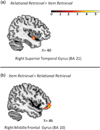Event-related functional magnetic resonance imaging changes during relational retrieval in normal aging and amnestic mild cognitive impairment
- PMID: 22622022
- PMCID: PMC3864110
- DOI: 10.1017/S1355617712000689
Event-related functional magnetic resonance imaging changes during relational retrieval in normal aging and amnestic mild cognitive impairment
Abstract
The earliest cognitive deficits observed in amnestic mild cognitive impairment (aMCI) appear to center on memory tasks that require relational memory (RM), the ability to link or integrate unrelated pieces of information. RM impairments in aMCI likely reflect neural changes in the medial temporal lobe (MTL) and posterior parietal cortex (PPC). We tested the hypothesis that individuals with aMCI, as compared to cognitively normal (CN) controls, would recruit neural regions outside of the MTL and PPC to support relational memory. To this end, we directly compared the neural underpinnings of successful relational retrieval in aMCI and CN groups, using event-related functional magnetic resonance imaging (fMRI), holding constant the stimuli and encoding task. The fMRI data showed that the CN, compared to the aMCI, group activated left precuneus, left angular gyrus, right posterior cingulate, and right parahippocampal cortex during relational retrieval, while the aMCI group, relative to the CN group, activated superior temporal gyrus and supramarginal gyrus for this comparison. Such findings indicate an early shift in the functional neural architecture of relational retrieval in aMCI, and may prove useful in future studies aimed at capitalizing on functionally intact neural regions as targets for treatment and slowing of the disease course. (JINS, 2012, 18, 1-12).
Conflict of interest statement
The authors report no conflicts of interest.
Figures




References
-
- Anderson ND, Ebert PL, Jennings JM, Grady CL, Cabeza R, Graham SJ. Recollection- and familiarity-based memory in healthy aging and amnestic mild cognitive impairment. Neuropsychology. 2008;22:177–187. - PubMed
-
- Brainerd CJ, Reyna VF. Gist is the gist: The fuzzy-trace theory and new intuitionism. Developmental Review. 1990;10:3–47.
-
- Buckner RL, Andrews-Hanna JR, Schacter DL. The brain’s default network: Anatomy, function, and relevance to disease. Annals of the New York Academy of Sciences. 2008;1124:1–38. - PubMed
-
- Burgess PW, Simons JS, Dumontheil I, Gilbert SJ. The gateway hypothesis of rostral prefrontal cortex (area 10) function. In: Duncan J, Phillips L, McLeod P, editors. Measuring the mind: Speed, control, and age. Oxford: Oxford University Press; 2005. pp. 217–248.
Publication types
MeSH terms
Grants and funding
LinkOut - more resources
Full Text Sources
Medical

